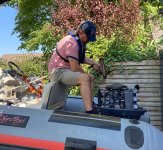Soaring Skipper
New member
Hi fellow boaters, outboard engine mechanics,
I've purchased an older style Yamaha outboard in dire need of a revision. It's a two stroke three cylinder 70 HP long tail from 1989 (70ETLF), that has been converted to short tail (70 CES?), with a 17 pitch prop (5000 RPM ≈ 50 kmh). This because in Holland it's very hard to find 70 HP short tail, 60 HP short tails are somewhat easier to find, but still not in abundance). My RIB has a max of 70 HP (hence this engine) and my budget did not stretch to a four stroke. And I like doing a revision myself, so here I am.
After completing a total rebuild (new oversize pistons, bearings, seals, etc etc, all original Yamaha, carbs ultrasonically cleaned) I've started the 10 hour running-in process. This type still has the manual setting of the ignition stops, and the preferred methods (test prop or test bench) were not really an option due to budget constraints and lack of availability mid season. So I had to do it myself. I remembered my favorite outboard mechanic Stu from whom I've learned almost all my outboard mechanic skills (big shout out to you Stu! https://www.youtube.com/c/DangarStu) mentioning the "Joe Reeves Method" (http://www.marineengine.com/boat-forum/archive/index.php/t-454594.html) as alternative for hanging off your boat trying to point a timing gun at your growling outboard while facing backwards doing 50 kmh (31 mph).
Stu intends to test this method in practice, but hasn't come around to it just yet. And I couldn't find anyone else online who had tested this method, but did want to apply it. I guess that makes me the guinea pig for this method. So here I found myself this weekend, doing the hanging backwards-growling-gun-50 kmh-method. I did manage to time my engine correctly with the timing gun, so there is no more risk of overheating because of too much advanced ignition. But I would not recommend doing this with big waves. Step one finished.
Plan was to set the timing according to the manual in real life (done), and after that reverse-check the setting with the "Joe Reeves Method", so I will know it works from practice and will not have to jump through the hoops of real life testing again next time.
These things I still have to do:
- Take a picture of how I a was seated while testing in the wild, in case anyone wonders.
- Compression test (for reference).
- Test the engine again with the "Joe Reeves Method", so I can see if this method indeed comes up 4 degrees short of the max advanced degrees (20° for the 70ETLF).
- Post my other findings while testing.
I intend to post it within the next week.
I've purchased an older style Yamaha outboard in dire need of a revision. It's a two stroke three cylinder 70 HP long tail from 1989 (70ETLF), that has been converted to short tail (70 CES?), with a 17 pitch prop (5000 RPM ≈ 50 kmh). This because in Holland it's very hard to find 70 HP short tail, 60 HP short tails are somewhat easier to find, but still not in abundance). My RIB has a max of 70 HP (hence this engine) and my budget did not stretch to a four stroke. And I like doing a revision myself, so here I am.
After completing a total rebuild (new oversize pistons, bearings, seals, etc etc, all original Yamaha, carbs ultrasonically cleaned) I've started the 10 hour running-in process. This type still has the manual setting of the ignition stops, and the preferred methods (test prop or test bench) were not really an option due to budget constraints and lack of availability mid season. So I had to do it myself. I remembered my favorite outboard mechanic Stu from whom I've learned almost all my outboard mechanic skills (big shout out to you Stu! https://www.youtube.com/c/DangarStu) mentioning the "Joe Reeves Method" (http://www.marineengine.com/boat-forum/archive/index.php/t-454594.html) as alternative for hanging off your boat trying to point a timing gun at your growling outboard while facing backwards doing 50 kmh (31 mph).
Stu intends to test this method in practice, but hasn't come around to it just yet. And I couldn't find anyone else online who had tested this method, but did want to apply it. I guess that makes me the guinea pig for this method. So here I found myself this weekend, doing the hanging backwards-growling-gun-50 kmh-method. I did manage to time my engine correctly with the timing gun, so there is no more risk of overheating because of too much advanced ignition. But I would not recommend doing this with big waves. Step one finished.
Plan was to set the timing according to the manual in real life (done), and after that reverse-check the setting with the "Joe Reeves Method", so I will know it works from practice and will not have to jump through the hoops of real life testing again next time.
These things I still have to do:
- Take a picture of how I a was seated while testing in the wild, in case anyone wonders.
- Compression test (for reference).
- Test the engine again with the "Joe Reeves Method", so I can see if this method indeed comes up 4 degrees short of the max advanced degrees (20° for the 70ETLF).
- Post my other findings while testing.
I intend to post it within the next week.


